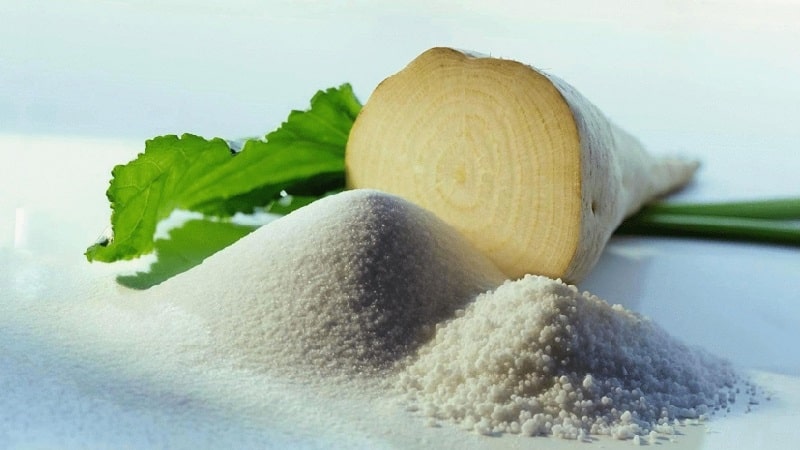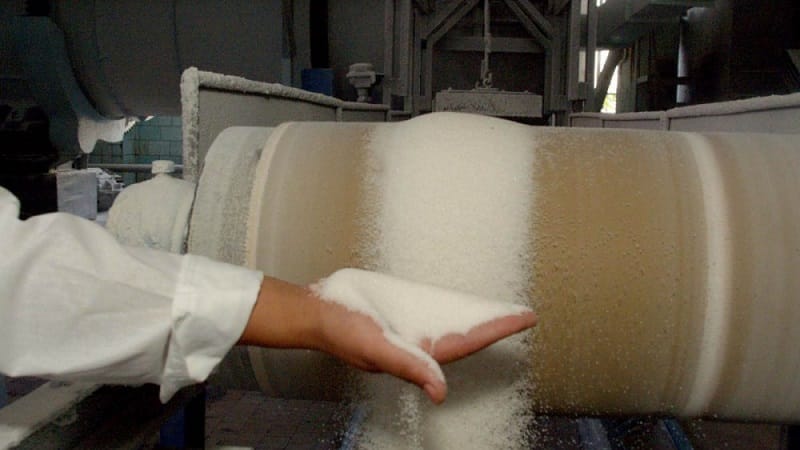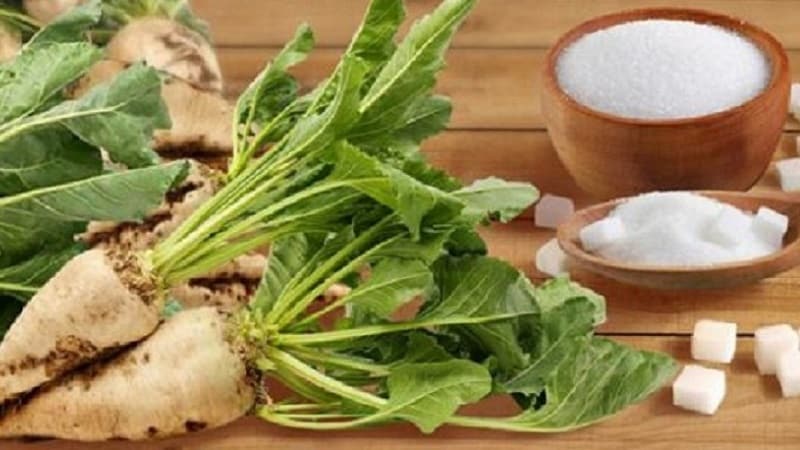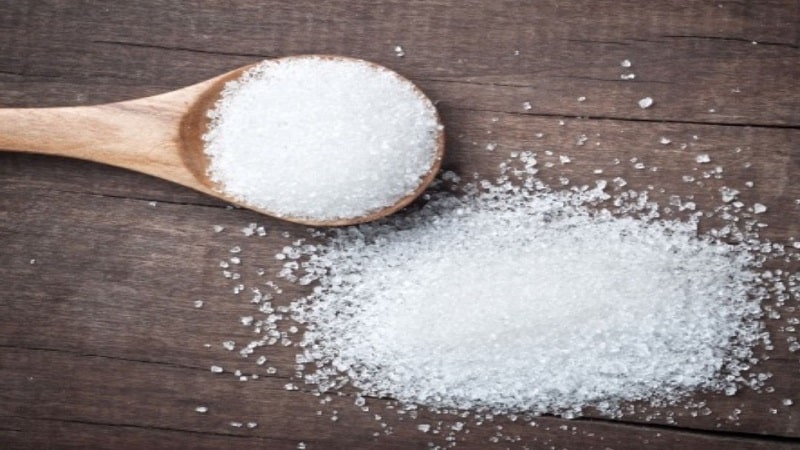How is sugar made from beets in a factory and is it possible to get it at home yourself?
Russia ranks second in the world after the United States in the production of sugar from beets. Over two centuries, processing technology has remained virtually unchanged. Only factories have become automated and now require only human control.
In this article you will learn how sugar is made from beets and whether this experience can be repeated at home.
The best varieties of sugar beets
The tubers of this crop contain about 20% sugars. This has made it possible to successfully extract sugar from them for many years.
The best varieties are considered:
- Bohemia - produces large fruits (up to 2 kg) with rapid ripening and long storage.
- Bona - fruits of 300 g each, the variety is drought-resistant.
- Araxia is characterized by high productivity (800 fruits are obtained from 1 hectare of land).
- Big Ben - its yield is 700 units per 1 hectare, the fruits are not prone to the formation of voids in the pulp.

How sugar is obtained from sugar beets at the factory
The process of obtaining sugar from root crops takes place in an automated plant and includes several stages.
Selection of raw materials
After the beets are delivered to the plant, the fruits are weighed and selectively inspected for integrity and sugar concentration.. The fruits are then unloaded onto a conveyor belt that leads to a washing machine.
Washing
There are various traps located on the conveyor. They separate large debris: pieces of earth, stones, grass, and also cut off tops. The sink itself is a rotating drum into which a stream of water is supplied.
The fruits, under the influence of friction against each other and a strong jet, are cleaned of remaining contaminants. The entire process is controlled by the operator: he monitors the quality of the wash on the monitor.
cutting
Next, clean vegetables are sent to the next stage - slicing. Blades are installed inside a special machine. The fruits, falling under the knife, turn into shavings.
Reference. The amount of sugar extracted in the future largely depends on the quality of this stage. The chips should be smooth and thin.
Sugar extraction
Now the chips are sent to the diffuser. It is a column, inside of which there is an auger (screw, like in a meat grinder). The movement of chips along it occurs from bottom to top. Water flows continuously against the movement of the beets, from top to bottom. The sugar contained in the beets dissolves. The whole process takes place at a certain temperature and without oxygen. At the end of diffusion, sweet beet syrup remains at the bottom of the column, and desugared chips remain at the top.
Reference. Pressed sugar beet pulp is not thrown away. It is dried and fed to livestock.

The process of extracting sugar from one batch lasts 100 minutes.
Juice cleanse
Juice in its original form is not subject to crystallization. In addition to 13% sugar, it contains about 2% of various impurities. They are removed with burnt lime, which picks up unnecessary particles.
Condensation and crystallization
Condensation occurs in vacuum devices. The atmosphere in them is rarefied, which allows the syrup to boil at 70 degrees. This is done because at higher temperatures the sugar will simply burn.
Thus, the liquid is boiled in six stages and becomes thicker and more concentrated.. As a result, the juice contains not 13% sugar, but 60%.
It can be useful:
How to properly use beetroot decoction for various diseases
Formation of sugar
Now the sugar crystals need to be separated from the liquid.. The concentrated juice is sent to a centrifuge, where, under the influence of centrifugal force, sugar settles on the walls of the drum.
Drying
The final stage. Wet sugar is transported to the drying chamber, where it is dried at a temperature of 100 degrees. The installation is in constant motion at this time. Granulated sugar is ready. All that remains is to cool it to room temperature in the same chamber.
How to make sugar at home
Despite the apparent complexity of the process, it can be easily repeated at home.. In a slightly simplified version, of course.
Necessary equipment
To obtain sugar in the easiest way you will need:
- beet;
- plate;
- oven;
- pot;
- heavy object for the press;
- a wide, low container, such as a basin.
For more successful sugar extraction, you can purchase an autoclave.. This is a special apparatus for heating at high temperatures under pressure above atmospheric pressure. It significantly speeds up the cooking process and increases the yield of the finished product. If you plan to prepare sugar at home all the time, then it will definitely come in handy.

Step-by-step manufacturing instructions
There is more than one way to make sugar at home. Below are brief step-by-step instructions.
Method one, “grandmother’s”:
- Wash the beets, peel them and cut into thin circles.
- Place them in a clay pot and put them in the oven or oven. Make sure that the circles do not burn.
- When the beets are soft, place them on a baking sheet and put them back in the oven to dry.
- All that remains is to grind the dried slices into flour, and homemade granulated sugar is ready.
Advice. Some of the slices can be left unchopped. They go great with unsweetened tea.
Method two, obtaining syrup:
- Wash the beets, trim the roots and tops with tops. There is no need to remove the skin.
- Place the fruit tightly in a pan of boiling water. There should be a lot of water so that the upper parts of the root crops do not open after evaporation.
- Cook for one hour. Wait for the beets to cool and remove the skins.
- Thinly slice the pulp into slices up to 1 mm thick.
- Cut these plates crosswise into thin strips. Wrap the straw in a piece of cloth and put it under a press.
- Place the resulting pulp back into the pan and add water in a ratio of beet volume to water of 2:1.
- Cook for 30 minutes. Pour the liquid from the pan into that obtained from the press.
- Place the cake in a cloth and put it under the press again.
- Pour the resulting juice into a saucepan and heat to 70-80 degrees.
- Strain the juice through several layers of gauze.
- Pour the strained juice into a wide, low container and cook over low heat until thickened. At this time, excess moisture will evaporate.
- Place the syrup in the freezer.
- Grind the frozen syrup in a coffee grinder or cut into cubes, like refined sugar.
Method three, technologically advanced:
- Wash the root vegetables, peel them and put them in an autoclave.
- Steam the beets at a pressure of 1.5 atm. until the pulp softens.
- Grind the fruits and pass through the press twice, as in the second method.
- Evaporate the strained liquid in the same way until a thick syrup is formed.
- Freeze and chop.

Result
Since at home there is no necessary technological base in the form of centrifuges, diffusion apparatus, burnt lime, etc., the volume of sugar is much less. To get 1 kg of granulated sugar, you will need to process 5 kg of root vegetables. Moreover, the result is not pure, familiar sugar, but diluted syrup.
The total sugar content in homemade syrup will be only 5% of the total mass.
Read also:
What are the benefits of beet tops and how can they be used?
How to recognize a beet allergy and quickly get rid of its symptoms
Differences from the process of obtaining cane sugar
Despite the popular belief that cane sugar is better than beet sugar, in fact they are exactly the same in composition. Refined, they have the same white color, taste and composition.
If we talk about unrefined forms, there are differences, and they are significant. Unrefined beet sugar is not suitable for food, but cane sugar, on the contrary, is highly valued. It has a caramel flavor and a warm brown color.
The main and only difference in the process of obtaining sugar from cane is that the cane is not crushed. The juice is immediately squeezed out of it. The remaining stages in the factory are the same: evaporation, filtration, crystallization and drying.
Let's sum it up
Obtaining sugar at home is quite a troublesome and time-consuming task. It will not be possible to prepare exactly the same granulated sugar as in the store due to the complexity of the equipment. Even if you have something more technologically advanced than a regular saucepan - an autoclave, you can only partially increase the volume of the finished product and speed up the process.
The average productivity of home methods is 1 kg of sugar from 5 kg of beets. Be that as it may, producing sugar at home is a very interesting experience and an opportunity to switch to sugar self-sufficiency, when you don’t have to depend on the prices for it in the store.